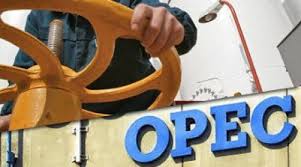
A decision by the OPEC to lift a production ceiling resulted in global fall in oil prices influencing the investors and experts to predict that the oil prices would remain low for even a longer period of time.
The OPEC decision also resulted in U.S. crude futures reaching a value of below $60 a barrel – a 10 year low.
Locking profitable prices for future deliveries would, in all probabilities, be possible for U.S. shale producers as they are one of the casualties of OPEC's strategy of pumping hard to retain market share.
Last week, the Organization of the Petroleum Exporting Countries failed to agree on an output target to reduce a bulging oil glut that has cut prices by over 60 percent since 2014. Following this the U.S. crude futures for front-month delivery fell below $40 per barrel on Monday.
Investors had unusually been willing to pay more to protect against a surprise rally in the price than a surprise fall in the run-up to the OPEC decision.
The investors are once again expecting a higher likelihood of further declines than that of a bounce back which is described as the bet has now been unwound. The option that gives the holder the right to sell crude oil futures at just $35 a barrel is one of the most popular options contract.
"Oil is going to make lower lows and lower highs for the foreseeable future and, in terms of market reaction post-OPEC, I'm not surprised, but it does leave the door open for prices to fall," Gain Capital analyst Fawad Razaqzada said.
Just before the OPEC meeting and as recently as late November, the U.S. crude for December 2022 delivery and onward was trading slightly above $60 per barrel. This fell down to below $60 for contracts out to December 2024.
"It means that there is a loss of confidence in the market after OPEC, and people expect low prices to last longer", said Oystein Berentsen, managing director of crude oil at Strong Petroleum in Singapore.
"Hence the back of the curve will be under pressure from producer hedging via selling the back of the curve to limit loss or lock in a small profit to reduce risk," Berentsen said.
Goldman Sachs said after the OPEC-meeting that it expected oil prices to remain "lower for longer," with a risk that oil prices could fall as low as $20 per barrel.
"The rising probability that markets may need to adjust through 'operational stress', when surpluses breach capacity, leaves risks to our forecast as skewed to the downside in coming months, with cash costs near $20 per barrel," the bank said.
It has been quite some time that bearishness has been brewing in the derivatives market. In the last two months, holdings of December 2016 put options at $25, $30 and $35 a barrel have risen 41 percent, options data shows. The open interest in those three contracts now equates to nearly 90 million barrels of oil.
(Source:www.reuters.com)
The OPEC decision also resulted in U.S. crude futures reaching a value of below $60 a barrel – a 10 year low.
Locking profitable prices for future deliveries would, in all probabilities, be possible for U.S. shale producers as they are one of the casualties of OPEC's strategy of pumping hard to retain market share.
Last week, the Organization of the Petroleum Exporting Countries failed to agree on an output target to reduce a bulging oil glut that has cut prices by over 60 percent since 2014. Following this the U.S. crude futures for front-month delivery fell below $40 per barrel on Monday.
Investors had unusually been willing to pay more to protect against a surprise rally in the price than a surprise fall in the run-up to the OPEC decision.
The investors are once again expecting a higher likelihood of further declines than that of a bounce back which is described as the bet has now been unwound. The option that gives the holder the right to sell crude oil futures at just $35 a barrel is one of the most popular options contract.
"Oil is going to make lower lows and lower highs for the foreseeable future and, in terms of market reaction post-OPEC, I'm not surprised, but it does leave the door open for prices to fall," Gain Capital analyst Fawad Razaqzada said.
Just before the OPEC meeting and as recently as late November, the U.S. crude for December 2022 delivery and onward was trading slightly above $60 per barrel. This fell down to below $60 for contracts out to December 2024.
"It means that there is a loss of confidence in the market after OPEC, and people expect low prices to last longer", said Oystein Berentsen, managing director of crude oil at Strong Petroleum in Singapore.
"Hence the back of the curve will be under pressure from producer hedging via selling the back of the curve to limit loss or lock in a small profit to reduce risk," Berentsen said.
Goldman Sachs said after the OPEC-meeting that it expected oil prices to remain "lower for longer," with a risk that oil prices could fall as low as $20 per barrel.
"The rising probability that markets may need to adjust through 'operational stress', when surpluses breach capacity, leaves risks to our forecast as skewed to the downside in coming months, with cash costs near $20 per barrel," the bank said.
It has been quite some time that bearishness has been brewing in the derivatives market. In the last two months, holdings of December 2016 put options at $25, $30 and $35 a barrel have risen 41 percent, options data shows. The open interest in those three contracts now equates to nearly 90 million barrels of oil.
(Source:www.reuters.com)





